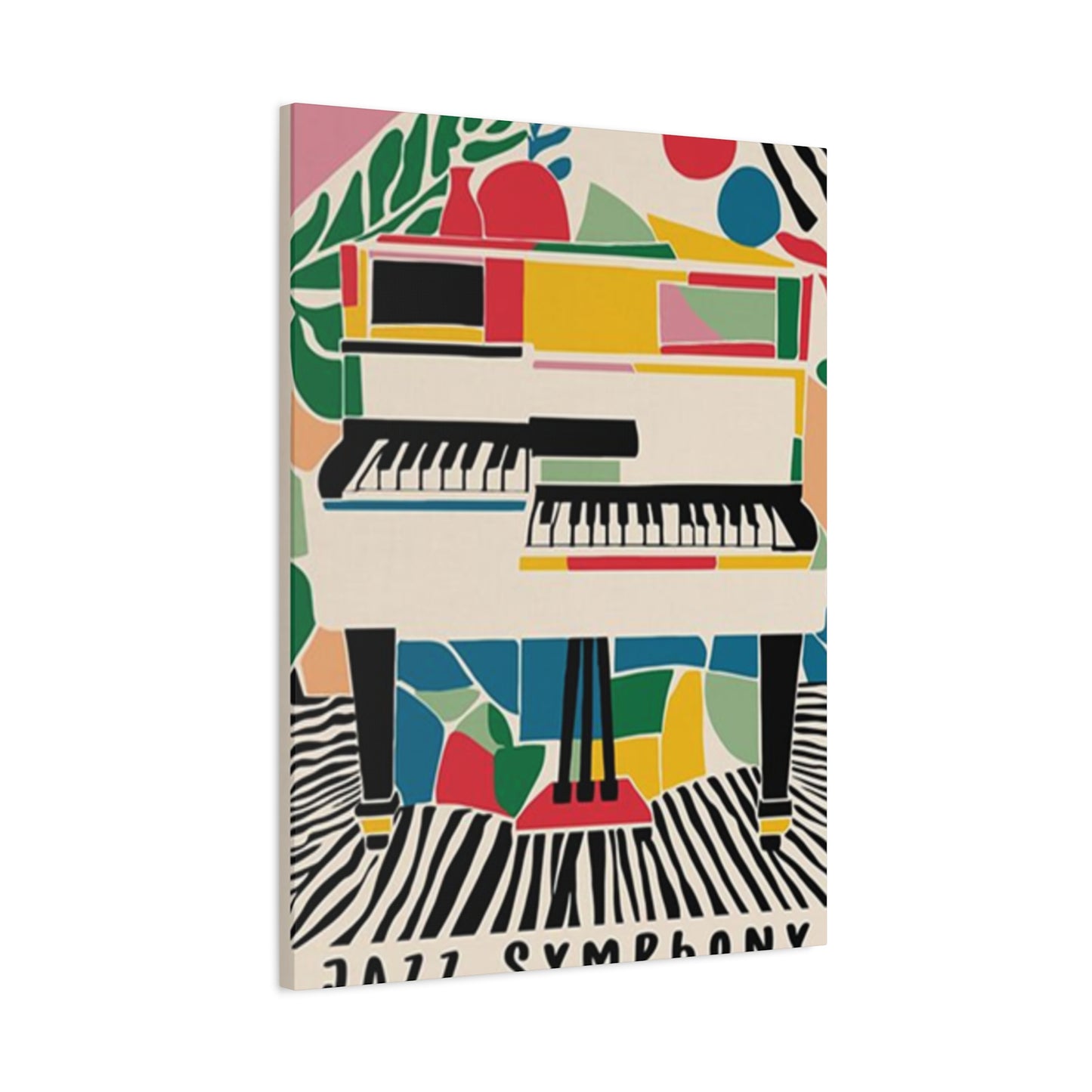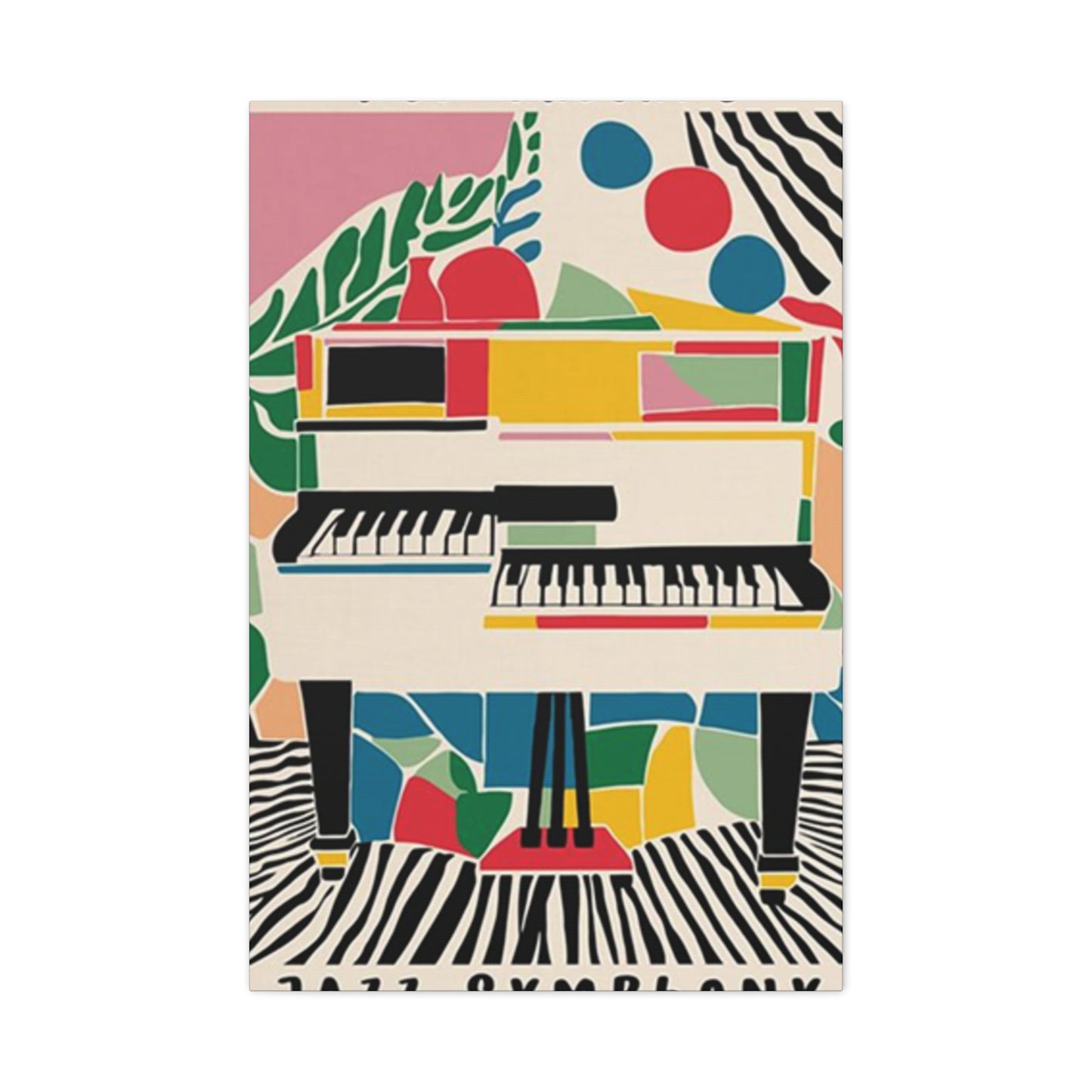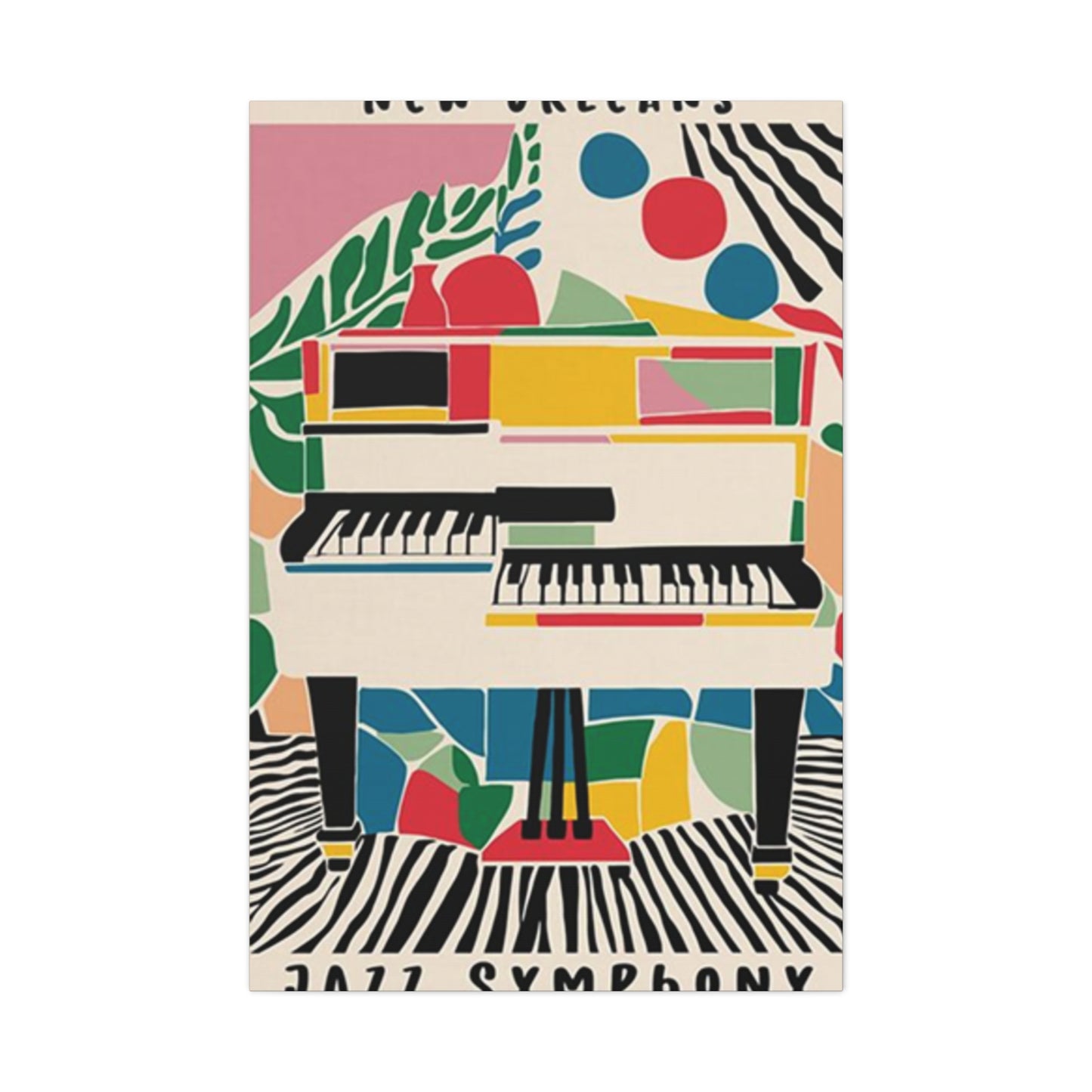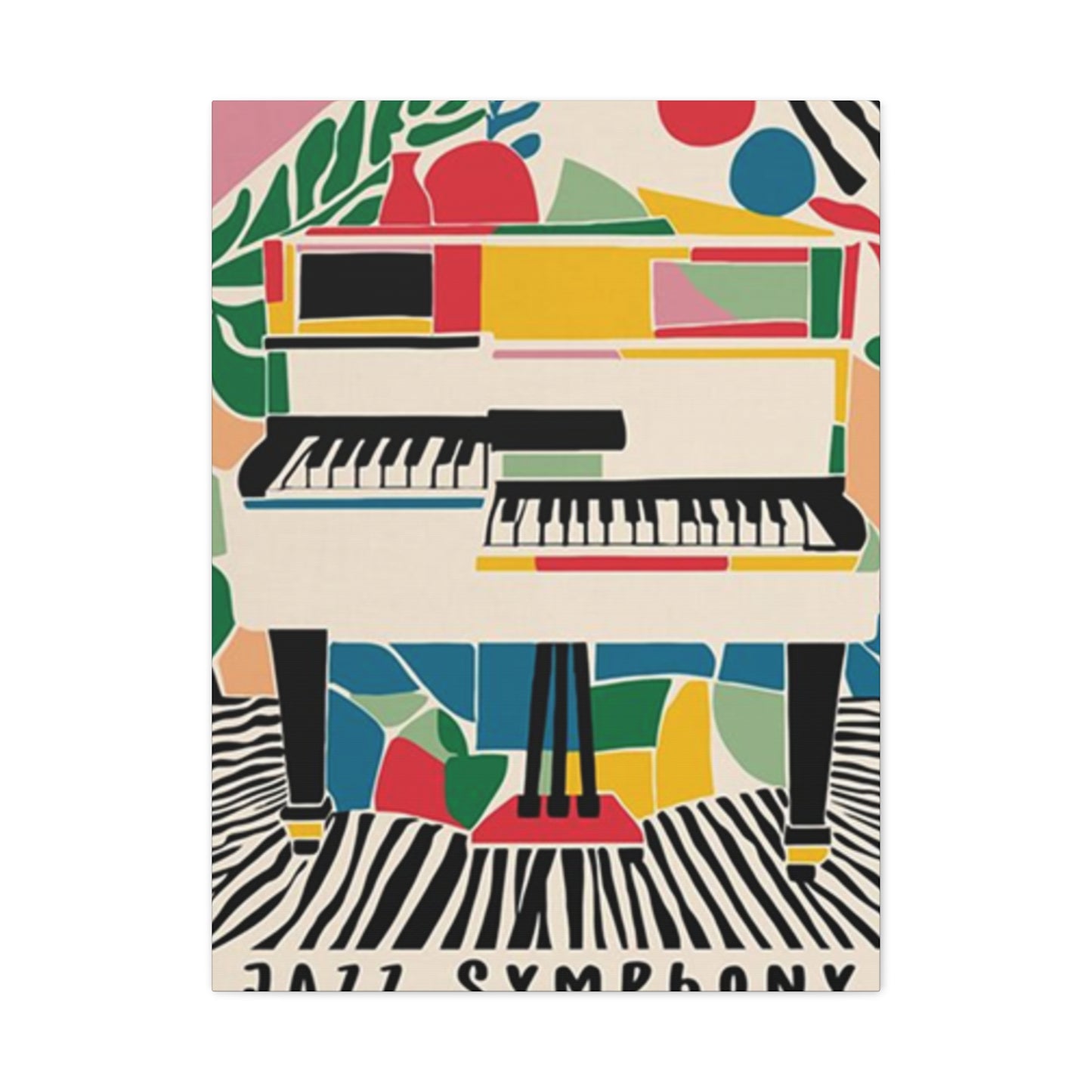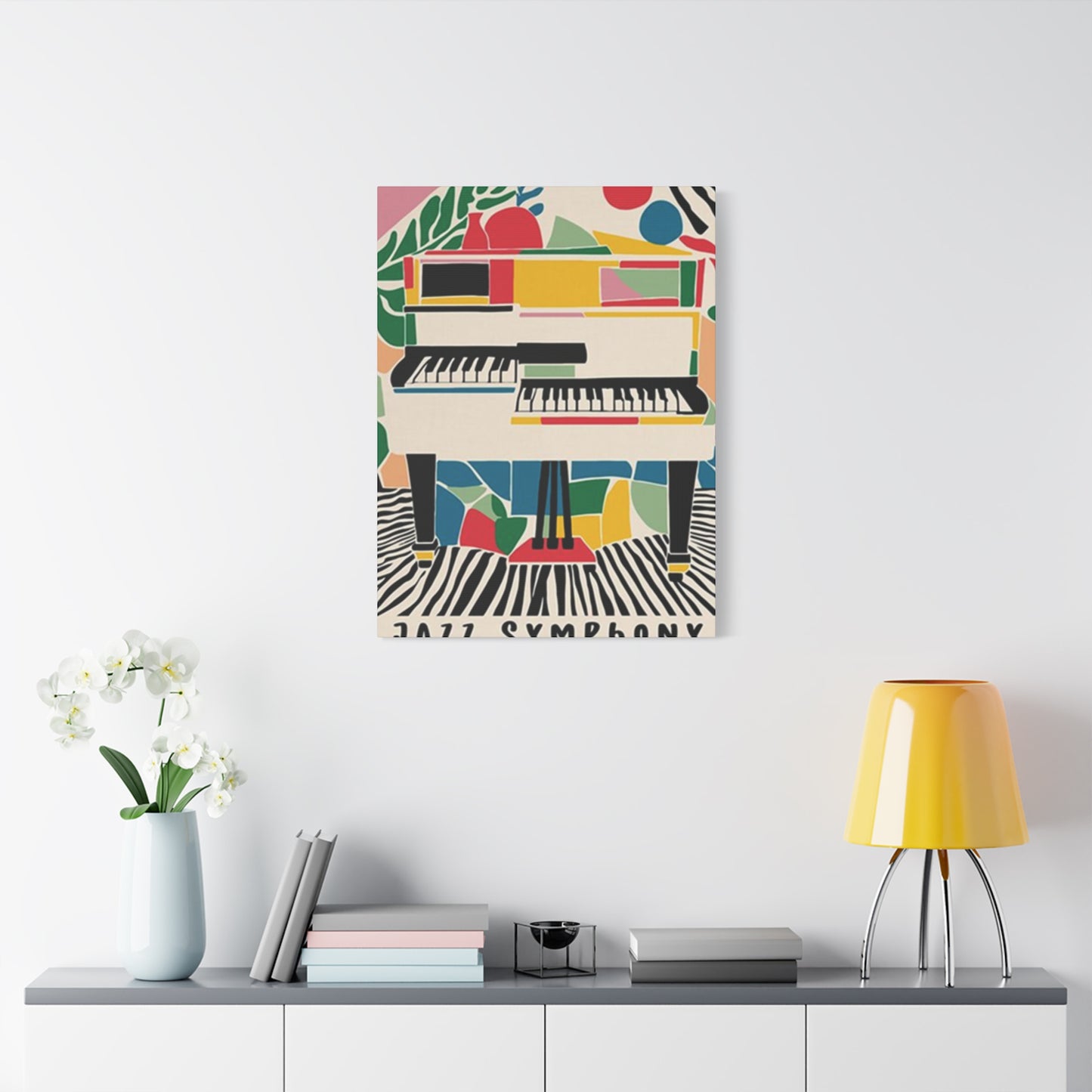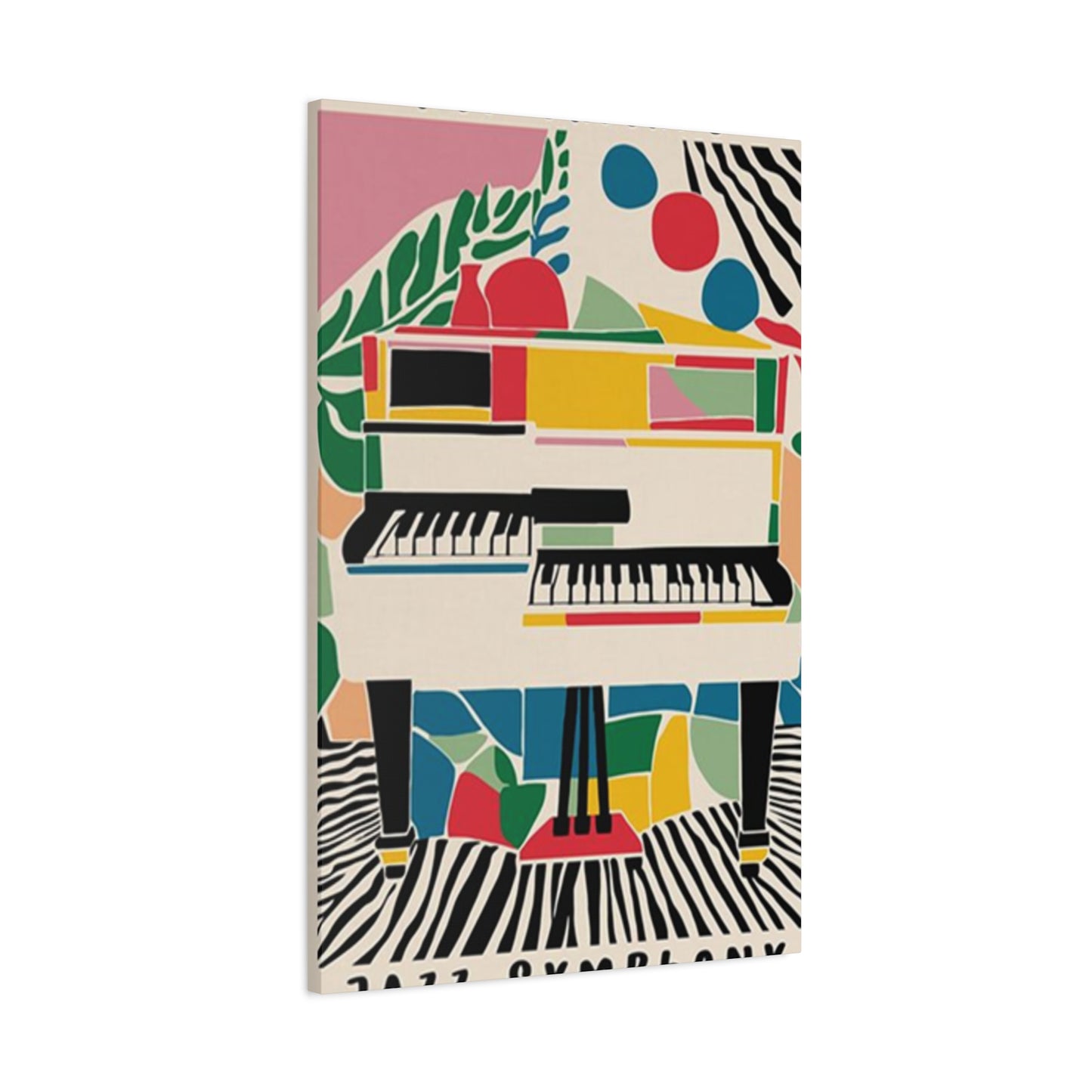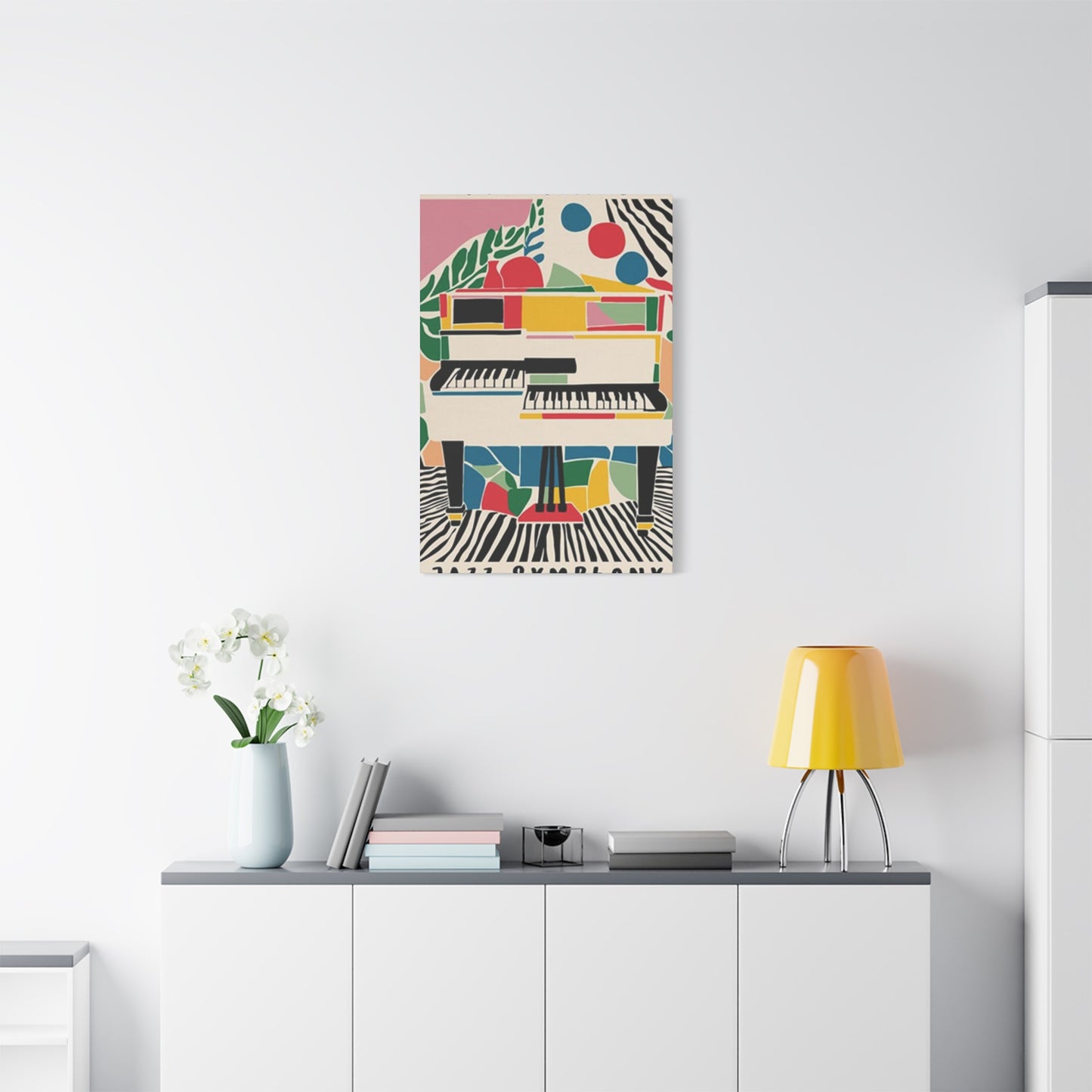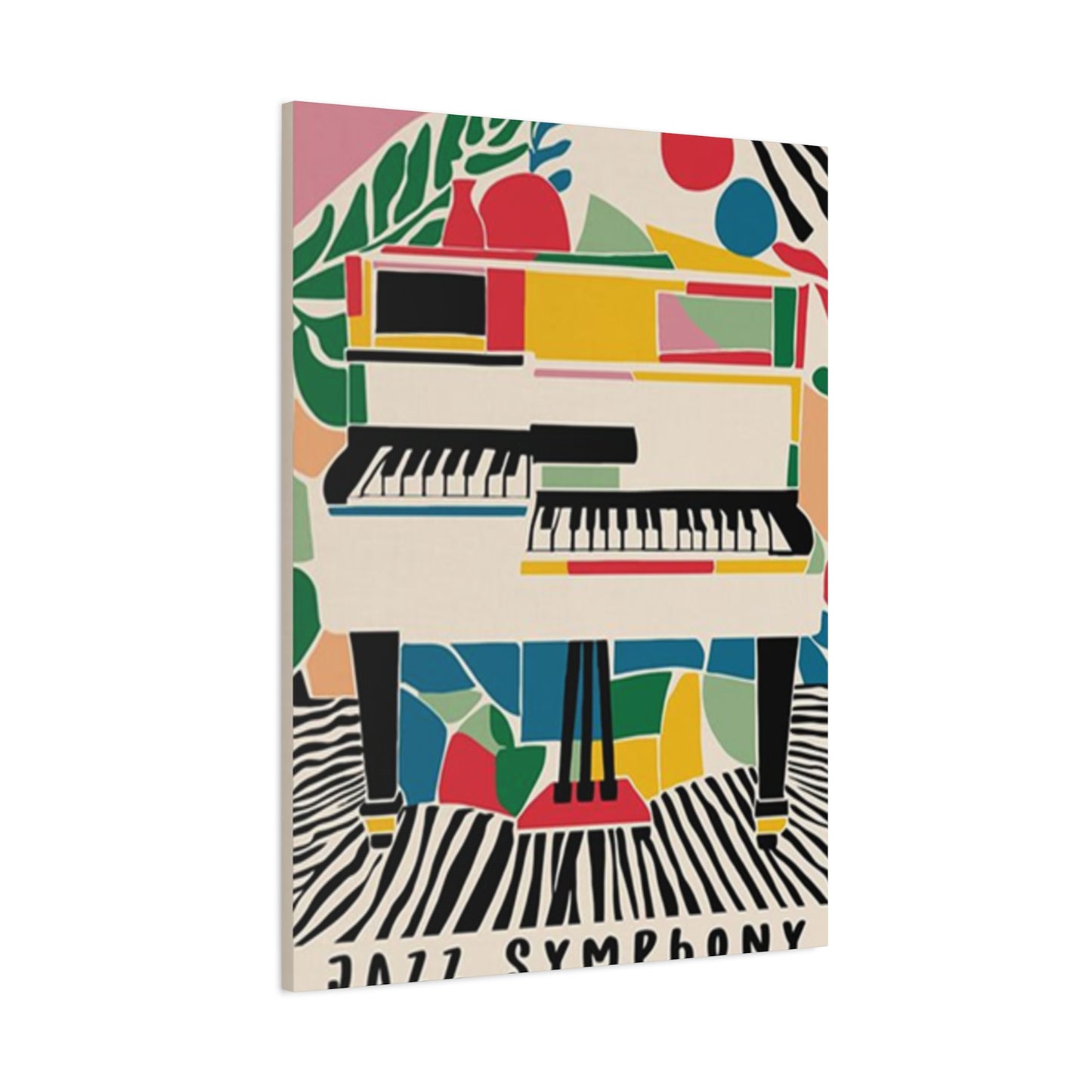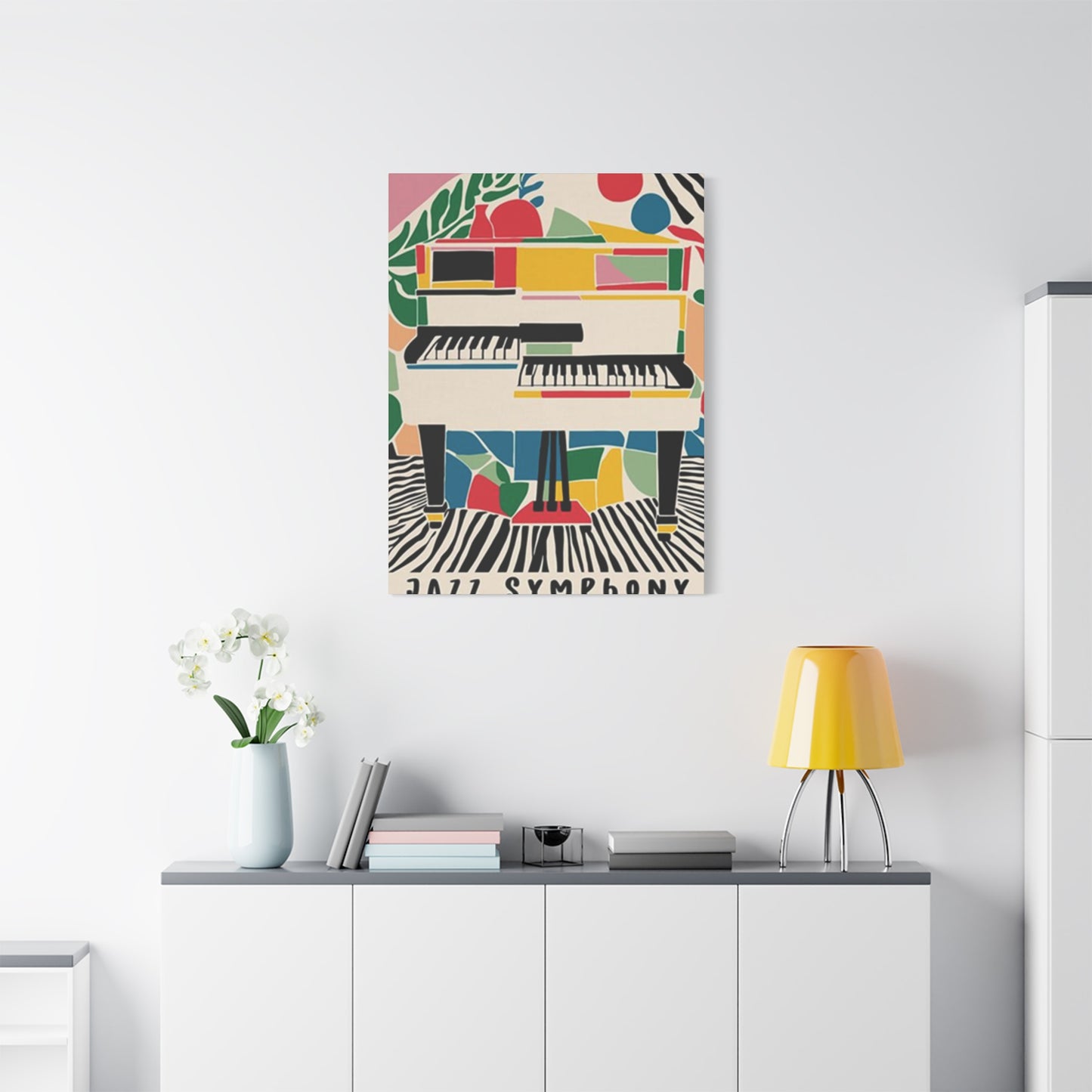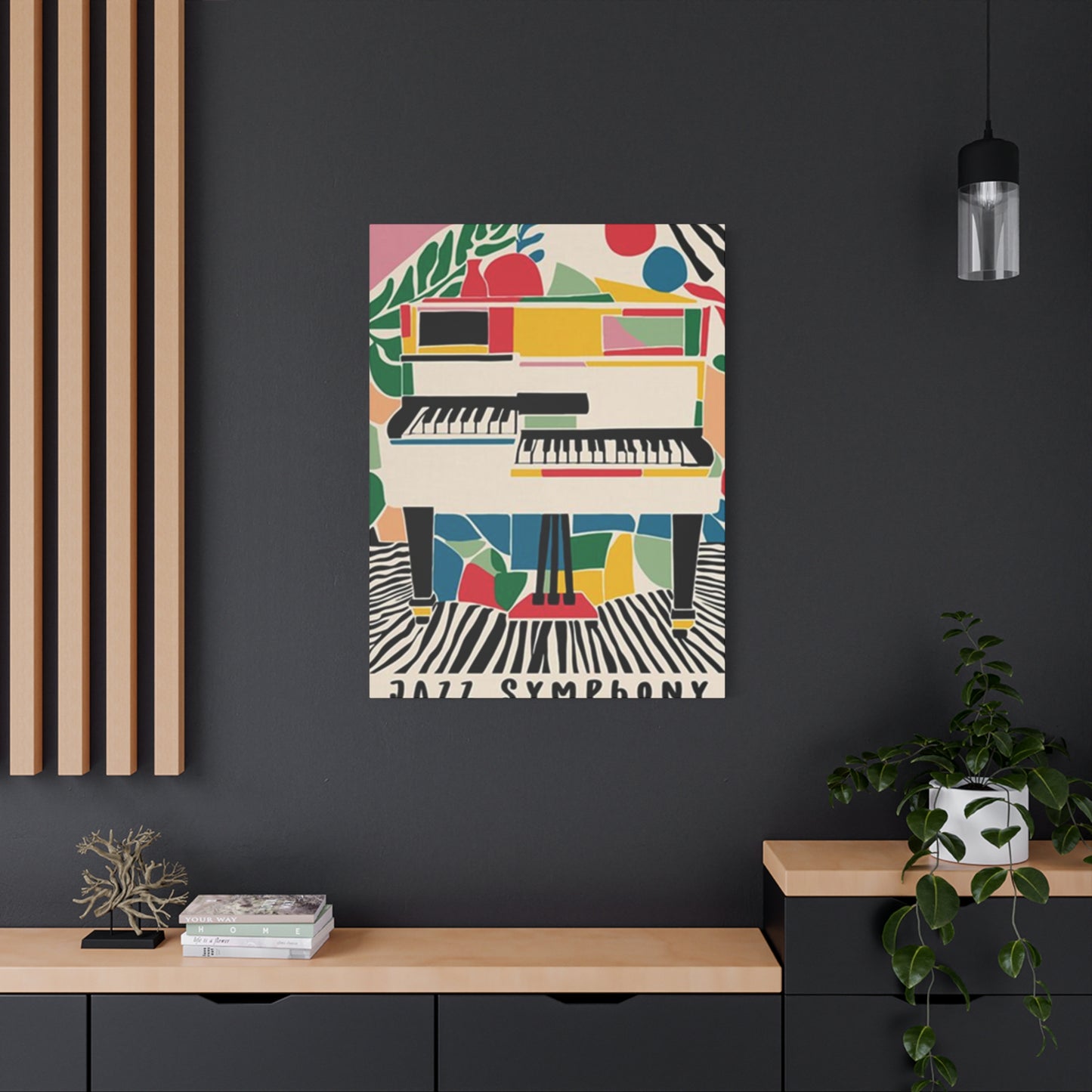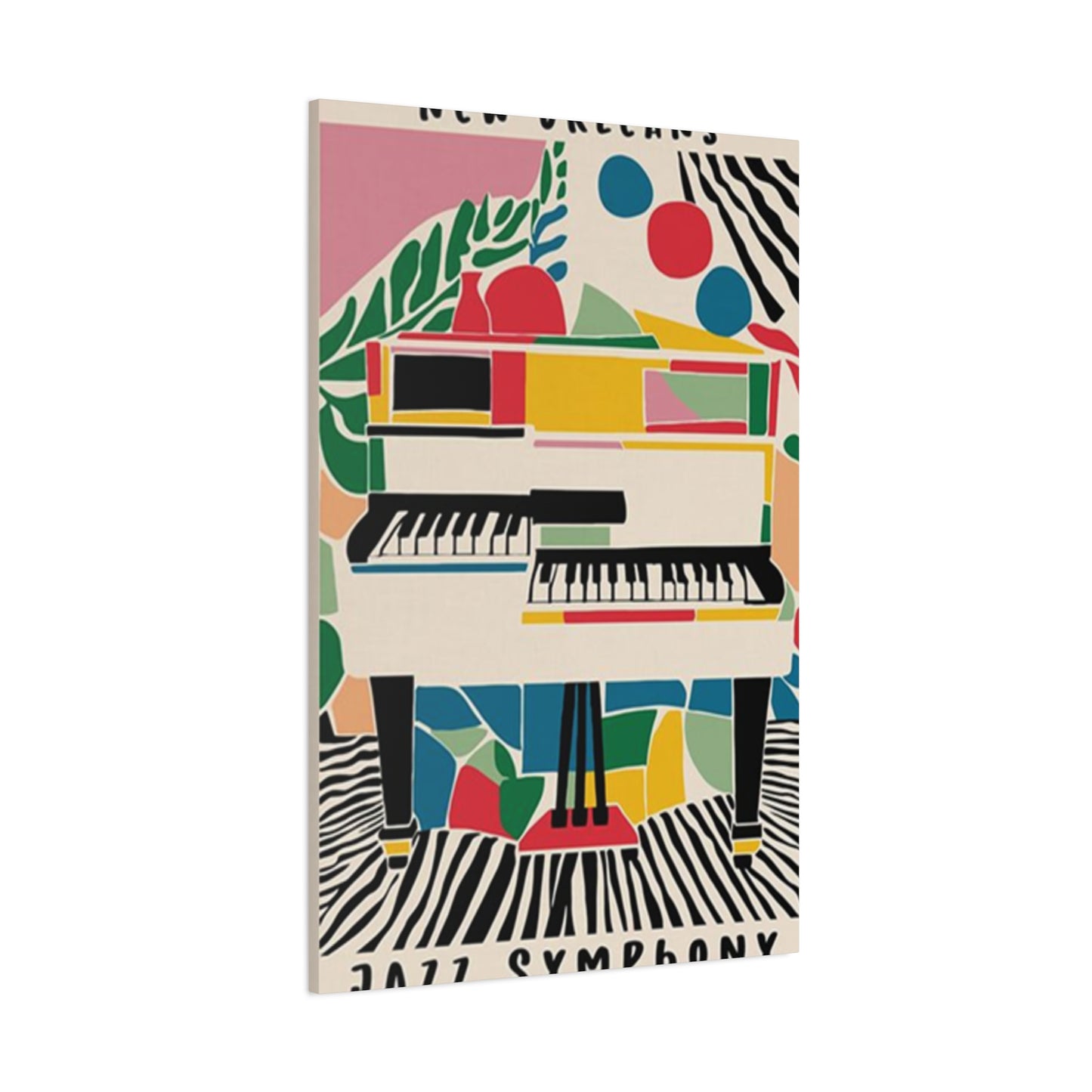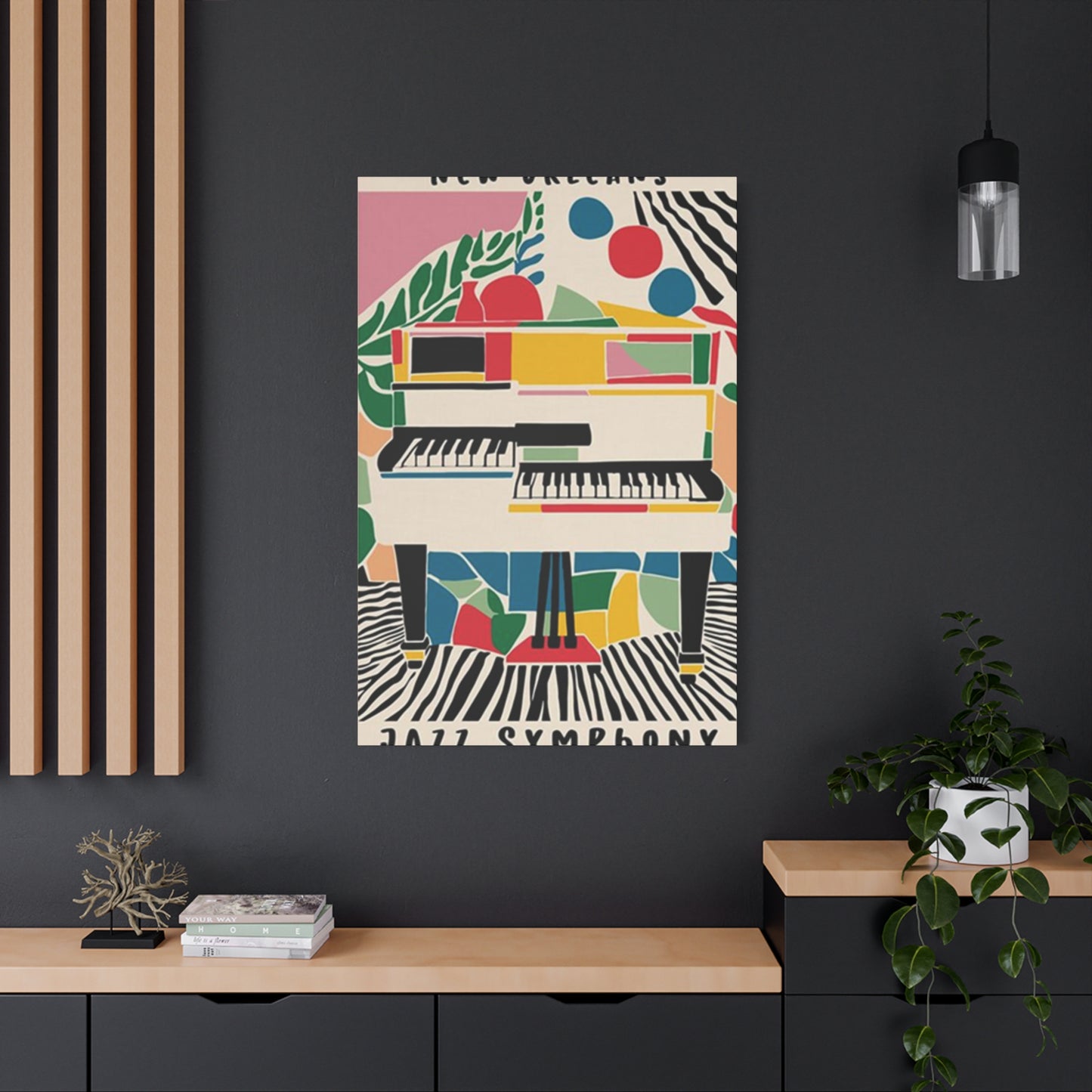Jazz Symphony Wall Art & Canvas Prints
Jazz Symphony Wall Art & Canvas Prints
Couldn't load pickup availability
Jazz Symphony Wall Art: The Vibrant Expression of Musical Energy Through Visual Design
The convergence of musical rhythms and visual aesthetics creates a powerful medium for home decoration that resonates with both music enthusiasts and art collectors. Jazz symphony wall art represents a distinctive category of decorative pieces that capture the spontaneity, emotion, and improvisational spirit inherent in jazz performances. These artistic representations translate the complex harmonies, syncopated rhythms, and expressive melodies of jazz into visual compositions that can transform any living space into a sanctuary of cultural appreciation and aesthetic sophistication.
The Cultural Significance Behind Musical Artwork Displayed in Modern Living Spaces
Musical-themed artwork has maintained its prominence throughout centuries of human civilization, serving as a bridge between auditory and visual sensory experiences. The representation of musical instruments, performers, and abstract interpretations of sound waves on canvas reflects humanity's enduring fascination with rhythm, melody, and harmony. When individuals select artwork depicting musical subjects, they make a conscious statement about their cultural values, personal interests, and aesthetic preferences.
The jazz genre particularly lends itself to visual interpretation due to its inherently expressive nature. Unlike more structured musical forms, jazz celebrates spontaneity, individual expression, and emotional authenticity. Artists who create visual representations of jazz performances often employ bold color palettes, dynamic compositions, and gestural brushwork that mirrors the improvisational quality of the music itself. These visual elements combine to create pieces that don't merely depict music but seem to emanate sonic vibrations through their composition.
Throughout the twentieth century, jazz emerged as more than just a musical genre—it became a cultural movement that challenged social norms, broke racial barriers, and provided a voice for marginalized communities. The visual documentation and artistic interpretation of jazz culture has preserved this legacy, allowing contemporary audiences to connect with the revolutionary spirit of legendary performers and groundbreaking compositions. Jazz symphony wall art serves as a constant reminder of this rich cultural heritage, bringing the energy of smoky nightclubs, intimate venues, and grand concert halls into residential and commercial environments.
Exploring Various Artistic Styles Within the Realm of Musical Visual Expression
The diversity within jazz-inspired artwork reflects the multifaceted nature of the genre itself. Artists employ numerous stylistic approaches when translating musical concepts into visual mediums, each offering unique aesthetic qualities and emotional resonances.
Abstract expressionism frequently appears in jazz-themed artwork, with artists using spontaneous brushstrokes, dripping paint, and gestural marks that echo the improvisational nature of jazz performances. These pieces prioritize emotional expression over representational accuracy, allowing viewers to experience the feeling of jazz rather than merely observing its external characteristics. The chaotic energy, unexpected color combinations, and seemingly random compositional elements mirror the unpredictable nature of a live jazz improvisation.
Figurative representations offer another popular approach, depicting musicians mid-performance with their instruments. These pieces capture specific moments of musical creation, freezing the physical gestures and facial expressions that accompany intense musical focus. The rendering of a saxophonist's cheeks inflated with air, a bassist's fingers dancing across strings, or a drummer's arms blurred in motion conveys the physicality of musical performance. Such representations connect viewers to the human element of music-making, reminding them that behind every beautiful sound stands a dedicated artist channeling their creativity through physical action.
Contemporary digital artists have embraced new mediums for creating jazz-inspired visuals, incorporating photographic elements, digital manipulation, and mixed media approaches. These modern interpretations often blend vintage imagery with contemporary design sensibilities, creating pieces that honor jazz's historical roots while presenting them through a fresh, current lens. The juxtaposition of old and new, traditional and modern, reflects jazz's own evolution from its early New Orleans origins through bebop, cool jazz, fusion, and contemporary experimental forms.
Minimalist interpretations strip jazz imagery down to its essential elements, using simple geometric shapes, limited color palettes, and clean lines to suggest musical concepts without explicit representation. A single curved line might evoke the arc of a trumpet bell, while concentric circles could reference the radiating sound waves emanating from a speaker. These simplified visual vocabularies require viewers to actively engage their imagination, completing the artistic statement through their own interpretive process.
The Psychological Impact of Displaying Musical Imagery Within Domestic Environments
The artwork individuals choose to display within their personal spaces significantly influences their emotional state, mental clarity, and overall wellbeing. Jazz symphony wall art offers specific psychological benefits that extend beyond mere aesthetic appeal.
Research into environmental psychology has demonstrated that visual stimuli in living spaces directly affect mood regulation, stress levels, and cognitive function. Artwork depicting musical subjects can trigger memories of meaningful experiences associated with particular songs, concerts, or periods in one's life. These associations create positive emotional responses that enhance overall life satisfaction and environmental comfort.
The dynamic, energetic quality characteristic of jazz-inspired artwork stimulates mental engagement and creative thinking. The visual complexity, unexpected compositional elements, and vibrant color relationships challenge viewers to actively process what they see, maintaining neural plasticity and cognitive vitality. Unlike more passive viewing experiences with overly simplistic or predictable imagery, jazz artwork demands attention and rewards prolonged observation with new discoveries and interpretations.
Color theory plays a crucial role in the emotional impact of jazz-themed artwork. The warm, saturated hues often employed in these pieces—deep blues reminiscent of late-night performances, vibrant yellows suggesting brass instruments, rich purples evoking atmospheric venues—create specific emotional atmospheres within spaces. Blues and purples promote relaxation and contemplation, making them ideal for bedrooms or meditation spaces, while yellows and oranges energize environments, suiting creative workspaces or social areas.
The presence of musical imagery also influences social dynamics within shared spaces. Jazz symphony wall art serves as a conversation catalyst, inviting guests to share their own musical experiences, preferences, and memories. This shared cultural reference point facilitates connection and communication, transforming decorative choices into social tools that foster community and relationship building.
Materials and Manufacturing Processes Behind High-Quality Canvas Productions
The creation of exceptional jazz symphony wall art involves careful consideration of materials, printing processes, and finishing touches that determine longevity, visual impact, and overall quality.
Canvas remains the preferred substrate for reproducing artwork due to its textural qualities, durability, and traditional association with fine art. Premium-grade canvas typically consists of either cotton or polyester fibers, each offering distinct characteristics. Cotton canvas provides a natural texture with slight irregularities that add organic warmth to printed images, while polyester canvas offers superior dimensional stability, resisting warping and stretching over time. Hybrid blends attempt to capture the benefits of both materials, though pure compositions generally deliver more predictable results.
The printing method dramatically influences the final appearance and longevity of artwork. Giclée printing represents the gold standard for fine art reproduction, utilizing archival-quality pigment-based inks that resist fading for decades when properly displayed. These specialized printers employ multiple ink cartridges—often twelve or more colors—enabling them to reproduce subtle tonal variations and color gradations that four-color commercial printing cannot achieve. The term "giclée" derives from the French word for "spray," referencing the microscopic ink droplets that create extraordinarily detailed images without visible dot patterns.
Dye-sublimation printing offers an alternative approach particularly suited for polyester substrates. This process uses heat to transfer dye directly into the fabric fibers rather than merely depositing ink on the surface. The resulting prints exhibit exceptional vibrancy and smoothness, with colors that remain stable through cleaning and environmental exposure. However, this method's limitation to synthetic materials makes it unsuitable for those preferring natural fiber canvases.
Gallery wrapping represents the standard mounting method for canvas artwork, stretching the printed fabric around wooden stretcher bars so the image continues around the sides of the frame. This presentation style eliminates the need for additional framing while creating a substantial, gallery-ready appearance. The depth of stretcher bars varies from thin .75-inch profiles to robust 2-inch depths that create dramatic shadow effects against walls.
Protective coatings applied after printing safeguard artwork from environmental damage. UV-resistant varnishes filter harmful light wavelengths that cause color deterioration, while water-resistant treatments protect against accidental splashes and humidity exposure. Matte finishes eliminate glare for optimal viewing from any angle, while gloss coatings enhance color saturation and contrast for more dramatic visual impact.
Selecting Appropriate Dimensions for Maximum Visual Effectiveness in Various Room Settings
The physical size of artwork dramatically affects its visual impact, relationship to surrounding architectural elements, and ability to establish focal points within designed spaces. Thoughtful size selection ensures jazz symphony wall art achieves its intended decorative and emotional effects.
Living rooms typically accommodate larger statement pieces that command attention and establish the space's aesthetic direction. Artwork measuring 40x60 inches or larger creates sufficient visual weight to anchor seating arrangements and balance substantial furniture pieces. In spacious rooms with high ceilings, even larger formats—60x80 inches or beyond—prevent artwork from appearing insignificant against expansive walls. The relationship between artwork size and viewing distance follows established proportions; viewers should stand approximately 1.5 to 2 times the artwork's diagonal measurement away for optimal appreciation of compositional details.
Bedroom environments generally benefit from more intimate artwork scales that promote relaxation rather than overwhelming visual stimulation. Pieces measuring 24x36 inches to 40x50 inches provide sufficient presence above headboards without dominating these restful spaces. Multiple smaller pieces arranged in thoughtful groupings can create visual interest while maintaining the peaceful atmosphere essential for quality sleep environments.
Hallways and transitional spaces present unique challenges due to their narrow dimensions and transient nature. Vertical orientations often work better in these constrained areas, with tall, narrow pieces complementing corridor proportions. Multiple smaller works arranged in gallery-style groupings transform otherwise overlooked passages into curated exhibition spaces that reward movement through the home with sequential visual experiences.
Home offices and creative workspaces benefit from moderately sized artwork—30x40 inches to 36x48 inches—that provides visual interest and inspiration without causing distraction during focused work periods. The energizing qualities of jazz imagery can stimulate creativity and maintain mental engagement during lengthy work sessions, while appropriate sizing prevents the artwork from competing with necessary functional elements like computer monitors, bookshelves, and task lighting.
Dining areas present opportunities for bold artistic statements that enhance social gatherings and meal experiences. Artwork displayed in these spaces should complement the scale of dining tables and surrounding furniture while accounting for typical viewing distances during seated meals. Horizontal compositions often work particularly well in dining rooms, their width mirroring table proportions and creating harmonious visual relationships.
Color Coordination Strategies for Harmonious Interior Design Schemes
The successful integration of jazz symphony wall art into existing interior design schemes requires thoughtful consideration of color relationships, tonal values, and visual balance. Strategic color coordination elevates artwork from merely decorative to transformative.
Complementary color schemes create vibrant, energetic environments by pairing colors opposite each other on the color wheel. Jazz artwork featuring warm oranges and cool blues generates visual tension and excitement, reflecting the genre's own dynamic contrasts between tension and resolution, structure and spontaneity. These high-contrast combinations demand attention and inject vitality into spaces that might otherwise feel static or bland.
Analogous color harmonies employ hues adjacent on the color wheel, creating cohesive, flowing visual experiences. Artwork featuring blues, blue-violets, and violets establishes moody, atmospheric environments reminiscent of dimly lit jazz clubs. These harmonious schemes feel naturally unified, requiring less visual adjustment from viewers and promoting relaxed, contemplative states.
Monochromatic approaches utilize various tones, shades, and tints of a single hue, creating sophisticated environments with subtle depth. Black and white jazz photography or artwork featuring gradations of a single color brings focus to compositional elements, textures, and forms rather than relying on color variety for visual interest. These restrained palettes project elegance and timelessness while allowing other design elements—furniture, textiles, architectural details—to contribute additional color accents.
Triadic color schemes employ three colors equally spaced around the color wheel, offering vibrant diversity while maintaining balance. Jazz artwork incorporating red, yellow, and blue—primary colors that reference the foundational elements of music theory—creates playful, energetic environments suitable for creative spaces or areas dedicated to entertainment and social gathering.
When integrating jazz symphony wall art into rooms with established color schemes, designers can choose between matching and contrasting approaches. Matching strategies select artwork whose dominant colors already appear elsewhere in the room—upholstery, curtains, rugs—creating cohesive, unified spaces where all elements feel intentionally coordinated. Contrasting approaches deliberately select artwork whose colors differ from existing schemes, using the piece as an accent that introduces new hues and generates visual excitement through unexpected combinations.
The proportional distribution of colors within artwork matters as much as the specific hues present. Pieces dominated by a single color with small accents of contrasting shades create different effects than works featuring equal distributions of multiple colors. Dominant colors establish overall mood and atmosphere, while accent colors provide visual punctuation and points of interest that guide eye movement through compositions.
Arrangement Principles for Creating Compelling Multi-Panel Displays
Gallery walls and multi-panel installations offer opportunities to create expansive visual narratives that single pieces cannot achieve. Strategic arrangement principles transform collections of individual artworks into cohesive installations that maximize visual impact.
Symmetrical arrangements provide formal, balanced compositions that convey stability and order. Centering a large focal piece with equally sized works flanking either side creates classical compositions suitable for traditional interiors. This approach works particularly well with triptychs—three related panels designed as unified compositions—where left and right panels mirror each other while the central panel commands primary attention.
Asymmetrical arrangements embrace visual tension and dynamic energy, reflecting jazz's improvisational spirit through unpredictable compositional choices. These layouts might feature a large anchor piece positioned off-center with smaller works clustered asymmetrically around it, creating movement and preventing static, predictable arrangements. The key to successful asymmetry lies in achieving visual balance despite physical imbalance—larger pieces on one side balanced by multiple smaller works or intense color concentrations on the opposite side.
Grid layouts impose ordered structure on multiple pieces, creating unified fields of imagery that read as singular installations despite consisting of separate elements. Maintaining consistent spacing between pieces—typically 2 to 3 inches—and aligning all edges creates the clean, organized appearance characteristic of this approach. Grid arrangements work well with series of related images or thematically connected pieces that collectively tell broader stories than individual works could convey alone.
Salon-style arrangements, inspired by traditional European exhibition practices, densely pack walls with artwork of various sizes, creating visually rich environments that reward extended viewing. These eclectic displays celebrate abundance and variety, allowing collectors to showcase extensive collections within limited wall space. Successful salon walls require careful planning to ensure visual coherence despite apparent randomness; maintaining consistent frame styles, color palettes, or thematic connections prevents chaos and maintains intentionality.
Horizontal line arrangements align the tops, bottoms, or centers of multiple artworks along invisible horizontal lines, creating visual calm and orderliness. This approach works particularly well above furniture pieces, where aligned artwork tops relate to the horizontal line created by sofa backs or cabinet tops below.
The spacing between multiple pieces significantly impacts overall visual effect. Minimal spacing—1 to 2 inches—causes separate pieces to read as unified installations, while wider spacing—4 to 6 inches or more—emphasizes the individuality of each work. The relationship between artwork spacing and wall color matters significantly; wider spacing on darker walls creates dramatic floating effects, while minimal spacing on lighter walls generates unified visual fields.
Practical Considerations for Proper Hanging and Secure Mounting Solutions
The proper installation of jazz symphony wall art ensures both aesthetic effectiveness and physical security, protecting valuable pieces while achieving optimal visual presentation.
The standard guideline positions artwork so its center sits at eye level, typically 57 to 60 inches from the floor. This measurement derives from average human height and gallery exhibition standards that prioritize comfortable viewing without neck strain. However, this rule requires contextual adjustment; rooms with particularly high or low ceilings may benefit from alternate positioning, and artwork displayed in areas where viewers are typically seated—dining rooms, bedroom seating areas—should hang lower to accommodate reduced viewing heights.
The distance between artwork and underlying furniture affects compositional relationships and visual balance. General guidelines suggest leaving 6 to 8 inches between furniture tops and artwork bottoms, creating clear visual separation while maintaining relational connection. Larger artwork may require increased spacing to prevent overwhelming furniture pieces, while smaller works can hang closer without appearing cramped.
Hardware selection depends on artwork weight, wall construction, and desired security level. Lightweight pieces under 10 pounds typically mount adequately on standard picture hangers with single nails. Medium-weight pieces between 10 and 25 pounds require more substantial hardware—double-nail hangers or wall anchors that distribute weight across larger surface areas. Heavy artwork exceeding 25 pounds demands specialized hanging systems: drywall anchors rated for appropriate weight, screws driven directly into wall studs, or professional picture-hanging systems with adjustable hooks and reinforced wire.
Canvas artwork stretched on gallery-wrapped frames offers simplified hanging through sawtooth hangers attached directly to stretcher bars or wire strung between screw eyes. Wire hanging systems provide flexibility for leveling and minor positioning adjustments, though they require V-shaped wire placement that ensures hooks support the wire's angle rather than bearing the full weight of straight-hanging wire that could slip.
Stud finders prove invaluable for locating solid wood framing members behind drywall, providing the most secure mounting points for heavy artwork. Electronic stud finders detect density changes behind wall surfaces, indicating stud locations where long screws can achieve maximum holding strength. When stud positioning doesn't align with desired artwork placement, hollow-wall anchors—toggle bolts, expansion anchors, threaded drywall anchors—provide alternative solutions that distribute weight across larger drywall areas rather than relying on single-point contact.
The use of leveling tools ensures artwork hangs straight, preventing the distracting tilt that undermines professional presentation. Standard bubble levels provide adequate accuracy for most installations, while laser levels project perfectly horizontal lines across entire walls, facilitating multi-piece installations where relative alignment matters. Many smartphone applications now include digital level functions, providing convenient leveling capabilities without dedicated tools.
Professional picture-hanging systems offer museum-quality solutions for those frequently rearranging artwork or managing extensive collections. These systems employ horizontal rails mounted near ceiling height with adjustable cables and hooks that allow artwork repositioning without additional wall penetrations. The flexibility and damage-free adjustment capabilities make these systems worthwhile investments for serious collectors despite higher initial costs.
Preservation Practices That Maintain Artwork Integrity Across Decades
Proper care and preventive measures significantly extend the lifespan of jazz symphony wall art, preserving color vibrancy, structural integrity, and overall aesthetic appeal through decades of display.
Direct sunlight represents the primary threat to artwork longevity, with ultraviolet radiation causing cumulative damage that fades pigments and degrades substrates over time. Positioning artwork away from windows receiving direct sun exposure provides basic protection, while UV-filtering window films or specialized glazing offer additional safeguards for pieces that must occupy sun-exposed locations. Even indirect daylight contains UV radiation; rooms with abundant natural light require more vigilant protection than darker interior spaces.
Artificial lighting similarly poses risks, though typically less severe than natural sunlight. LED bulbs generate minimal UV radiation compared to older incandescent and fluorescent alternatives, making them preferable for illuminating artwork. Halogen bulbs, while offering excellent color rendering properties, produce significant heat that can damage canvas and accelerate aging processes. When using halogen illumination, maintaining adequate distance between fixtures and artwork prevents heat accumulation.
Environmental humidity fluctuations stress canvas artwork, causing expansion and contraction cycles that eventually lead to cracking, warping, and delamination. Maintaining relative humidity between 40 and 60 percent provides stable conditions that minimize dimensional changes. Dehumidifiers prevent excessive moisture in humid climates, while humidifiers add necessary moisture in arid environments or during winter months when heating systems dry indoor air.
Temperature stability similarly affects artwork preservation, with dramatic fluctuations causing expansion and contraction stresses. Avoiding artwork placement near heating vents, air conditioning registers, fireplaces, and exterior walls subject to temperature swings helps maintain consistent conditions. The ideal temperature range for artwork preservation falls between 65 and 75 degrees Fahrenheit, though moderate variations within this range cause minimal damage.
Dust accumulation dulls colors and harbors moisture that promotes mold growth. Regular gentle dusting with soft, dry microfiber cloths removes surface debris without abrading protective coatings or canvas textures. Avoiding feather dusters, which can snag on canvas textures, and never using chemical cleaning products, which may react adversely with inks and coatings, prevents accidental damage during routine cleaning.
Periodic professional assessment provides expert evaluation of artwork condition and identifies emerging issues before they progress to serious damage. Conservators possess specialized knowledge of materials science, aging processes, and restoration techniques that enable them to recommend preventive measures tailored to specific pieces. While involving additional expense, professional conservation consultations represent worthwhile investments for valuable or irreplaceable artwork.
Protective framing under glass or acrylic provides maximum protection from environmental contaminants, physical damage, and UV exposure, though it compromises the texture and three-dimensional quality that makes canvas artwork appealing. For pieces of significant monetary or sentimental value, this trade-off may prove acceptable. Museum-quality glazing materials filter UV radiation while maintaining optical clarity, offering protection without the yellowing and degradation characteristic of standard acrylic.
The Investment Value and Collectibility of Contemporary Musical Artwork
Beyond aesthetic considerations, jazz symphony wall art represents a collectible category with potential investment value that combines personal enjoyment with financial appreciation possibilities.
The art market has historically demonstrated long-term value appreciation for works by recognized artists, particularly those associated with culturally significant movements or subjects. Jazz's enduring cultural relevance and continued influence on contemporary music ensures ongoing demand for jazz-related artwork from collectors, enthusiasts, and commercial spaces seeking authentic atmosphere.
Limited edition prints command higher values than unlimited reproductions due to scarcity principles that drive collector markets. Artists typically produce limited editions in runs of 50 to 500 pieces, numbering and signing each print to authenticate its limited status. Lower numbers within editions—particularly artist's proofs and early impressions—often carry premium values due to collector preferences for primary examples.
Provenance documentation tracking an artwork's ownership history, exhibition record, and authentication adds significant value and facilitates future resale. Maintaining purchase receipts, certificates of authenticity, condition reports, and correspondence with artists or galleries builds comprehensive provenance that assures potential buyers of a piece's legitimacy and history.
Emerging artists represent speculative investment opportunities where acquiring work early in careers positions collectors to benefit from potential future recognition and value appreciation. Researching artists' exhibition records, critical reception, awards, and representation by established galleries helps identify promising talents whose work may appreciate substantially as their reputations grow.
The commercial application of jazz symphony wall art extends beyond residential collecting into hospitality, entertainment, and corporate environments. Restaurants, hotels, music venues, and creative businesses frequently incorporate jazz-themed artwork to establish atmospheric authenticity and cultural credibility. This commercial demand creates consistent market support that stabilizes values and ensures ongoing interest from dealers and galleries.
Auction results provide market data indicating value trends for specific artists, subjects, and styles. Online auction platforms and traditional auction houses regularly feature jazz-related artwork, with realized prices establishing market values and identifying rising or declining demand patterns. Monitoring auction results helps collectors make informed acquisition and disposal decisions based on current market conditions.
Condition dramatically affects resale value, with pristine examples commanding significant premiums over damaged or deteriorated pieces. The preservation practices discussed previously directly support long-term investment value by maintaining artwork condition that maximizes potential future returns.
Insurance valuations provide professional assessments of artwork's replacement value, protecting collectors against loss from theft, damage, or destruction. Regular appraisal updates—typically every three to five years—ensure insurance coverage reflects current market values and protects collectors from inadequate compensation following losses.
Sourcing Authentic Pieces from Reputable Artists and Distributors
Navigating the artwork marketplace requires knowledge of sourcing channels, authentication practices, and quality indicators that separate exceptional pieces from mediocre reproductions.
Original artwork created by individual artists represents the pinnacle of collectibility and investment potential, offering unique pieces that cannot be duplicated. Galleries specializing in contemporary art provide curated selections from established and emerging artists, with knowledgeable staff offering insights into artists' backgrounds, techniques, and market positioning. Gallery representation itself signals professional recognition, as selective galleries carefully vet artists before offering representation.
Art fairs and exhibitions provide opportunities to view multiple artists' work in concentrated settings while interacting directly with creators. These events facilitate conversations about artistic processes, inspirations, and available inventory that deepen appreciation and inform purchasing decisions. Major art fairs in cultural centers attract international galleries and collectors, while regional and local fairs offer more accessible entry points for new collectors.
Online marketplaces have democratized art acquisition, connecting collectors directly with artists worldwide while eliminating gallery markup. However, online purchasing requires additional diligence regarding authentication, quality assessment, and return policies. Requesting detailed photographs, dimensions, materials specifications, and condition reports before purchasing reduces the risk of disappointing surprises upon delivery.
Artist websites and social media profiles provide direct access to creators, eliminating intermediaries while supporting artists who receive full proceeds from sales. Many artists maintain online shops featuring available work, pricing information, and commission opportunities for custom pieces. Direct artist relationships often yield insights into creative processes and future work that galleries cannot provide.
Print-on-demand services offer convenient access to jazz symphony wall art through vast online catalogs featuring thousands of designs. While these services provide affordability and convenience, they generally produce lower quality reproductions using basic printing processes and materials compared to fine art print studios. Evaluating print-on-demand providers requires assessing their printing methods, materials specifications, and sample images that demonstrate actual output quality.
Vintage and antique markets occasionally yield historic jazz-related artwork, posters, and photographs that offer authentic period pieces with cultural significance. Authentication becomes particularly crucial in these contexts, as reproductions and forgeries of valuable vintage pieces present risks to uninformed buyers. Consulting specialists in vintage music memorabilia or seeking pieces with documented provenance reduces these risks.
Custom commission opportunities allow collectors to acquire personalized jazz symphony wall art tailored to specific preferences, dimensions, and aesthetic requirements. Commissioning processes typically involve preliminary consultations discussing vision and requirements, followed by sketches or mockups for approval before final creation. While custom pieces require larger investments and extended timelines, they result in unique artwork perfectly suited to intended spaces and personal tastes.
Thematic Variations Within Jazz-Inspired Visual Representations
The broad subject of jazz offers numerous thematic directions for artistic exploration, each emphasizing different aspects of the music's rich cultural tapestry.
Instrumental focus pieces celebrate specific instruments central to jazz performance—saxophones, trumpets, double basses, drums, pianos. These works often feature detailed renderings that highlight the instruments' mechanical beauty, sculptural forms, and metallic or wooden textures. Close-up perspectives emphasize valves, keys, and strings as design elements, transforming functional objects into abstract compositions of curves, angles, and reflective surfaces.
Performer portraits capture legendary musicians whose innovations defined jazz's evolution. Images of icons—Louis Armstrong, Miles Davis, John Coltrane, Billie Holiday, Ella Fitzgerald—serve as tributes to their artistry while connecting viewers to jazz's storied past. Contemporary portraits of current performers document ongoing artistic evolution, celebrating new generations continuing jazz traditions while pushing boundaries into unexplored territories.
Venue and atmosphere pieces evoke the environmental context where jazz flourishes—dimly lit clubs, smoke-filled rooms, intimate stages, and animated audiences. These works emphasize mood and ambiance over specific details, using lighting effects, color atmospheres, and gestural figures to convey the experiential qualities of live jazz performance. The emphasis falls on capturing feelings—anticipation, energy, connection—rather than documentary representation.
Abstract interpretations translate musical concepts into purely visual vocabulary without representational imagery. Flowing lines suggest melodic phrases, while angular shapes reference rhythmic patterns. Color harmonies and contrasts mirror tonal relationships and harmonic progressions. These conceptual pieces require active viewer engagement, inviting personal interpretation and emotional response unmediated by recognizable imagery.
Historical documentation pieces preserve visual records of significant moments in jazz history—legendary performances, recording sessions, civil rights protests, cultural gatherings. These works carry documentary value beyond aesthetic appeal, serving as historical artifacts that educate contemporary audiences about jazz's role in social movements and cultural transformation.
Genre-specific pieces explore jazz's numerous substyles—New Orleans traditional, swing, bebop, cool, modal, free, fusion—each with distinctive characteristics warranting unique visual treatments. Swing-inspired artwork might emphasize movement and elegance through flowing figures and graceful compositions, while free jazz interpretations embrace chaos, fragmentation, and unconventional color relationships that mirror the music's experimental nature.
Cultural context pieces situate jazz within broader social, political, and cultural landscapes, acknowledging the genre's roots in African American communities and its role in civil rights struggles, cultural exchange, and artistic innovation. These works often incorporate historical imagery, documentary photographs, and symbolic elements that connect musical performance to larger narratives about identity, resistance, and creative expression.
The Role of Music-Themed Decoration in Defining Personal Identity and Cultural Affiliation
Decorative choices communicate personal identity, values, and cultural affiliations to inhabitants and visitors alike. Jazz symphony wall art makes specific statements about who we are and what we value.
Musical preference serves as powerful identity marker, signaling personality traits, generational membership, and subcultural affiliations. Jazz appreciation traditionally associates with sophistication, intellectualism, and cultural refinement, though contemporary jazz embraces diverse aesthetic approaches that complicate these stereotypes. Displaying jazz artwork announces musical sophistication while inviting conversations about specific preferences, favorite artists, and memorable concert experiences.
The specific jazz era or substyle represented in artwork further refines identity statements. Swing-era imagery suggests nostalgia for golden-age glamour and big band excitement, while bebop references signal appreciation for technical virtuosity and musical complexity. Free jazz artwork indicates openness to experimental approaches and avant-garde sensibilities, while fusion imagery suggests cross-cultural curiosity and genre-boundary rejection.
Musical artwork creates immediate rapport among like-minded individuals who recognize shared interests and values. Guests noticing jazz-themed decoration may reveal their own musical backgrounds, sparking conversations that forge connections and deepen relationships. This social bonding function transforms decoration from passive background into active relationship facilitator.
The presence of culturally significant artwork demonstrates engagement with broader cultural conversations beyond immediate personal experience. Jazz's historical role in civil rights struggles, cultural exchange, and artistic innovation makes its artistic representation inherently political in ways that purely decorative choices cannot achieve. Displaying jazz artwork acknowledges this cultural significance while aligning oneself with values of creativity, equality, and cultural appreciation.
Collecting specific artists or focusing on particular themes within jazz artwork develops connoisseurship that elevates casual decoration into serious cultural engagement. As collections grow and knowledge deepens, spaces transform into personal galleries that reflect years of learning, refinement, and passionate pursuit. This evolution from decoration to curation marks a qualitative shift in how spaces function and what they communicate.
The emotional resonance of personally meaningful artwork exceeds that of generic decoration selected purely for aesthetic coordination. A jazz symphony wall art piece might commemorate a significant concert experience, honor a beloved musician who has passed, or celebrate a formative period when jazz provided soundtrack to important life events. These personal connections infuse spaces with biographical significance that generic artwork cannot achieve.
Combining Musical Artwork with Complementary Decorative Elements
Jazz symphony wall art achieves maximum impact when thoughtfully integrated with complementary decorative elements that reinforce thematic coherence while avoiding heavy-handed literal matching.
Vintage audio equipment—turntables, tube amplifiers, reel-to-reel tape decks—positioned on shelving or dedicated furniture creates functional displays that link visual jazz appreciation to actual music listening. These pieces serve dual purposes as working audio systems and sculptural objects whose industrial design complements artwork's aesthetic. The combination of visual and auditory jazz elements creates multisensory environments that fully immerse inhabitants in jazz culture.
Musical instruments displayed as decorative objects extend artwork's thematic focus into three-dimensional space. A vintage saxophone on a stand, trumpet positioned on a shelf, or even unplayable decorator instruments introduce authentic materiality that printed artwork cannot provide. These physical objects carry the weight and texture of real musical tools, grounding abstract visual representations in tangible reality.
Lighting design significantly affects how artwork appears and how spaces feel. Warm-toned lighting—incandescent or warm-spectrum LED—enhances the atmospheric qualities of jazz imagery while creating intimate, club-like ambiance. Adjustable track lighting or picture lights illuminate artwork while providing flexibility to highlight specific pieces during gatherings or dim lighting for relaxed evening environments.
Textile selections offer opportunities to echo or complement artwork's color palettes and thematic elements. Velvet upholstery suggests the luxurious darkness of upscale jazz clubs, while geometric patterns on throw pillows might reference the structured rhythms underlying improvisational freedom. Area rugs in colors pulled from artwork create visual continuity between walls and floors, unifying spaces through repeated hues.
Metallic accents—brass, copper, bronze—reference the materials of jazz instruments while adding sophisticated glamour to spaces. Side tables with brass legs, copper pendant fixtures, or bronze decorative objects create subtle connections to trumpets, saxophones, and cymbals without requiring literal instrument imagery. The warm, reflective qualities of these metals enhance the sensory richness of jazz-inspired spaces.
Book displays featuring jazz biographies, criticism, photography collections, and music theory texts transform personal libraries into educational resources that demonstrate serious engagement with the subject. Artfully arranged books become decorative elements themselves while offering guests opportunities to explore jazz history and culture more deeply.
Record collections displayed on walls or shelving transform functional music libraries into visual elements that reinforce jazz themes. Vintage album covers offer stunning graphic design that complements painted or printed artwork, while extensive collections communicate passionate, long-term musical engagement.
Conclusion
Jazz's development across specific geographic locations generated distinct visual cultures that artists reference and reimagine in contemporary jazz symphony wall art.
New Orleans, jazz's birthplace, contributed visual iconography centered on street performance, second line parades, and the city's distinctive architectural and cultural landscape. Artwork referencing New Orleans jazz often incorporates wrought-iron balconies, crowded streets, colorful buildings, and outdoor performance scenes that capture the music's roots in public celebration and community gathering.
Chicago's role in jazz's northern migration during the Great Migration appears in urban imagery emphasizing industrial architecture, nighttime cityscapes, and indoor venues where musicians adapted New Orleans traditions to northern urban contexts. The sophisticated club scene that developed in Chicago's South Side generated visual culture focused on intimate venues, fashionable audiences, and emerging recording industry that documented jazz's evolution.
New York's Harlem Renaissance produced rich visual documentation as jazz intersected with broader African American cultural flowering encompassing literature, visual arts, and social activism. Artwork referencing this period often depicts crowded nightclubs like the Cotton Club and Small's Paradise, elegant performers in evening wear, and the vibrant street life that characterized Harlem's cultural peak.
Kansas City developed distinctive jazz culture during Prohibition's final years, with wide-open nightlife scenes generating visual imagery of exuberant performance, competitive jam sessions, and blues-influenced musical approaches. The city's relaxed enforcement of prohibition laws created environments where jazz flourished in after-hours clubs and large dance halls that accommodated hundreds of patrons.
West Coast cool jazz generated different visual aesthetics emphasizing restraint, sophistication, and experimental approaches. Artwork referencing this movement often employs subdued color palettes, minimalist compositions, and atmospheric effects that mirror the music's relaxed tempos and intellectual approach. The California lifestyle and entertainment industry connections influenced visual presentations that emphasized glamour and artistic innovation.
European jazz scenes developed their own visual cultures as American musical forms merged with local artistic traditions. French jazz clubs, British skiffle cellars, and Scandinavian experimental venues each generated distinctive imagery reflecting regional aesthetic preferences and cultural contexts. Contemporary artists draw on these international variations to create jazz artwork that acknowledges the genre's global reach and cross-cultural appeal.
Custom commissioned jazz symphony wall art offers opportunities to create highly personalized pieces that capture specific preferences, commemorate meaningful experiences, or fit exact dimensional and aesthetic requirements.
The commissioning process begins with identifying suitable artists whose existing portfolios demonstrate stylistic compatibility with desired outcomes. Reviewing previous work reveals technical capabilities, aesthetic preferences, and thematic focuses that indicate whether collaboration would prove successful. Artists specializing in portraiture suit projects emphasizing specific musicians, while those with abstract portfolios better serve conceptual pieces translating musical feeling into non-representational forms.
Share
